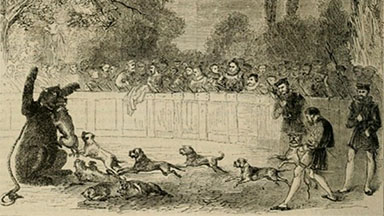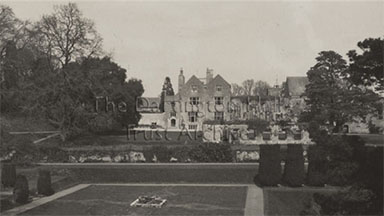My name is Katherine Ross and I am a gardener at The Dartington Hall Trust. Last year, I was given the huge privilege of spending one day a week researching the history of the gardens, so that a management plan could be written.
I hope to share with you the interesting titbits and conundrums that I come across while undertaking my research, and my first blog involves the emotive subject of bear baiting.
 Baiting is a blood sport that involved worrying and tormenting bears and bulls. The animals were often tied to a spike and worried by a number of well-trained hunting dogs, usually English bulldogs.
Baiting is a blood sport that involved worrying and tormenting bears and bulls. The animals were often tied to a spike and worried by a number of well-trained hunting dogs, usually English bulldogs.
It was very popular in England until the 19th century, and much enjoyed by Henry VIII and Elizabeth I, among others.
The Elmhirsts, previous owners of Dartington, tell us that baiting occurred in the Tiltyard, in the space below the Twelve Apostles (the line of 12 large, bowling pin shaped, Irish Yews opposite the Sunny Border).
In fact, it is suggested that the Apostles were planted to hide the sight of the baiting from the children in the nursery (which was in the top storey of the buildings behind). (2)
Leonard Elmhirst recalls that old Miss Champernowne (of the family who owned Dartington before the Elmhirsts) said that in the 1890s, her great Aunt had told her that when she was a small girl, she ‘remembered being pulled away from the nursery window at the top of the house and being forbidden by her nanny to look at the bull and bear baiting then going on in the sunken garden’. (3) (4)
 The tiltyard has had different incarnations, and, as far as we know, at the time in question the base was divided into two. The level below the Twelve Apostles was as it is today, and was called the ‘Sunken Garden’. But the rest was level with the first terrace up from the present Tiltyard floor (see image, right).
The tiltyard has had different incarnations, and, as far as we know, at the time in question the base was divided into two. The level below the Twelve Apostles was as it is today, and was called the ‘Sunken Garden’. But the rest was level with the first terrace up from the present Tiltyard floor (see image, right).
The conundrum is that the Twelve Apostles were planted in 1830, which would have allowed only five years growth, before baiting was banned in 1835. However, the ban may not have been predicted.
In the account outlined by Leonard Elmhirst, the baiting was occurring in the early 1800s, so possibly the Apostles were an afterthought, when children started bursting into tears.
I cannot find any conclusive evidence. Does anyone have any ideas? Here are some dates that may help:
1830 – Twelve Apostles planted (5)
1835 – Baiting prohibited by Parliament by the Cruelty to Animals Act thanks to a Bill introduced by South Durham MP Joseph Pease (a member of RSPCA committee). An initial attempt was made in the 1800, in a Bill produced by MP Sir William Pulteney, but lost as the future PM argued that “the amusement inspired courage and produced a nobleness of sentiment and elevation of mind” (6).
Katy Ross (previously gardener at Dartington Hall)
References
1. Mabillard, Amanda. What types of entertainment did they have in Elizabethan England? Shakespeare: General Q & A . [Online] August 20, 2000. [Cited: February 11, 2015.] https://www.shakespeare-online.com/faq/entertainment.html.
2. Elmhirst, Dorothy. How the Garden at Dartington was re-made . 1963 .
3. Elmhirst, Leonard. s.l. : News of the Day, October 26, 1955.
4. Young, Michael. The Elmhirsts of Dartington . Surrey : Biddles Ltd, 1996.
5. Nicholas Pearson Associates Ltd. Historic Landscape Survey and Restoration Plan. 2002.
6. Schoon, Nicholas. When baiting bears and bulls was legal… s.l. : Independant, 1997.
